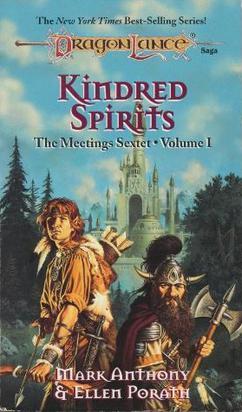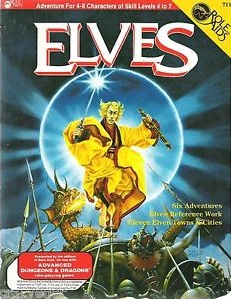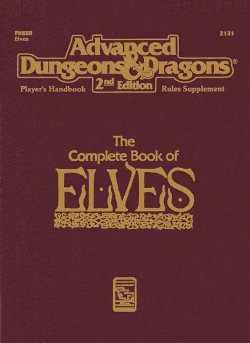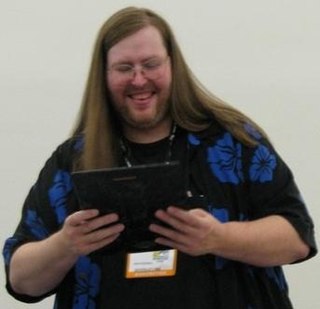Glorfindel is a fictional character in J. R. R. Tolkien's Middle-earth legendarium. He is a member of the Noldor, one of the three groups of the Calaquendi or High Elves. The character and his name, which means "blond" or "golden-haired", were among the first created for what would become part of his Middle-earth legendarium in 1916–17, beginning with the initial draft of The Fall of Gondolin. His name indicates his hair as a mark of his distinction, as the Noldor were generally dark-haired. A character of the same name appears in the first book of The Lord of the Rings, The Fellowship of the Ring, which takes place in Middle-earth's Third Age. Within the story, he is depicted as a powerful Elf-lord who could withstand the Nazgûl, wraith-like servants of Sauron, and holds his own against some of them single-handedly. Glorfindel and a version of the story of the Fall of Gondolin appear in The Silmarillion, posthumously published in 1977.

Elfquest is a comic book property created by Wendy and Richard Pini in 1978. It is a fantasy story about a community of elves and other fictional species who struggle to survive and coexist on a primitive Earth-like planet with two moons. Several published volumes of prose fiction also share the same setting. Elfquest was one of the first comic book series to have a planned conclusion. Over the years Elfquest has been self-published by the Pinis through their own company Warp Graphics, then Marvel Comics, then the Pinis again, more recently DC Comics, and, since 2013, Dark Horse Comics. All issues of Elfquest published prior to 2014 are available online for free.
A half-elf is a mythological or fictional being, the offspring of an immortal elf and a mortal man. They are often depicted as very beautiful and endowed with magical powers; they may be presented as torn between the two worlds that they inhabit. Half-elves became known in modern times mainly through J. R. R. Tolkien's Middle-earth writings but have origins in Norse mythology. A half-elf appeared in Lord Dunsany's 1924 book The King of Elfland's Daughter.
Ælfwine the mariner is a fictional character found in various early versions of J. R. R. Tolkien's Legendarium. Tolkien envisaged Ælfwine as an Anglo-Saxon who visited and befriended the Elves and acted as the source of later mythology. Thus, in the frame story, Ælfwine is the stated author of the various translations in Old English that appear in the twelve-volume The History of Middle-earth edited by Christopher Tolkien.

Those Who Hunt Elves is a Japanese manga series written and illustrated by Yu Yagami. The plot revolves around three travelers, the eponymous "Elf Hunters", and the elven sorceress Mistress Celcia. The anime was released in North America on VHS and DVD by ADV Films and later re-released by Sentai Filmworks.

Lawrence Andrew "Drew" Hayes was a writer and comic book artist who is best known as the creator of the long-running independent comic book series Poison Elves.

Inverloch is a series of five fantasy graphic novels authored by Sarah Ellerton drawn in a cel-shaded manga style. Inverloch was initially published as a webcomic with new content introduced several pages at a time from 2003 to 2007. Three volumes have seen print with the first three volumes currently available from IndyPlanet and with the first two originally published by Seven Seas Entertainment. Inverloch received several nominations in the 2005, 2006 and 2007 Web Cartoonist's Choice Awards, winning the Outstanding Fantasy Comic category in 2005. During its web publication Inverloch was highly rated at both Topwebcomics and buzzComix online comic rating sites.

In many works of modern fantasy, elves are depicted as a race or species of pointy-eared humanoid beings. These depictions arise from the álfar of Norse mythology influencing elves in fantasy as being semi-divine and of human stature, whose key traits are being friendly with nature and animals. However, this differs from Norse and the traditional elves found in Middle Ages folklore and Victorian era literature.

Jason Shawn Alexander or J. Alexander is a painter, illustrator and draftsman from Portland, Tennessee.

The Elves of Cintra is a fantasy novel by American writer Terry Brooks, the second in his epic fantasy trilogy The Genesis of Shannara. The series bridges the events of Brooks' Word & Void series with his acclaimed novel The Sword of Shannara and the subsequent trilogy. It immediately follows the novel Armageddon's Children. It details events during the Great Wars, a historical conflict referenced frequently in the Shannara books. The conclusion to the trilogy and the sequel to The Elves of Cintra is The Gypsy Morph, which was released in August 2008.

The Broken Sword is a fantasy novel by American writer Poul Anderson, originally published on 5 November 1954. It was issued in a revised edition by Ballantine Books as the twenty-fourth volume of their Ballantine Adult Fantasy series in January 1971. The original text was returned to print by Gollancz in 2002. The novel is set during the Viking Age and the story contains many references to the Norse mythology.

Kindred Spirits is a fantasy novel set in the Dragonlance fictional universe. It was written by Mark Anthony and Ellen Porath, based on characters and settings from Margaret Weis and Tracy Hickman's Dragonlance Chronicles series. Published in 1991, it is the first volume of a six-part series on how the Companions first met.
The half-elf is a player character race featured in Dungeons & Dragons and related material.
In J. R. R. Tolkien's writings, Elves are the first fictional race to appear in Middle-earth. Unlike Men and Dwarves, Elves are immortal, though they can be killed in battle. If so, their souls go to the Halls of Mandos in Aman. After a long life in Middle-earth, Elves yearn for the Earthly Paradise of Valinor, and can sail there from the Grey Havens. They feature in The Hobbit and The Lord of the Rings. Their history is described in detail in The Silmarillion.
Sirius Entertainment was an American comic book company that operated from 1994 to circa 2014. Sirius Entertainment was founded by Robb Horan, and Larry Salamone, and was dedicated from the outset to publishing creator-owned properties. Originally based in Stanhope, New Jersey, Sirius later moved to Unadilla, New York.

Amulet is a graphic novel series illustrated and written by Kazu Kibuishi and published by Graphix, an imprint of Scholastic. It follows the adventures of Emily, a young girl who discovers a sentient and autonomous magical circular amulet in her maternal great-grandfather's house.

Elves is a supplement for fantasy role-playing games published by Mayfair Games in 1983.

Skeleton Knight in Another World is a Japanese light novel series written by Ennki Hakari and illustrated by KeG. It began serialization online in October 2014 on the novel self-publishing website Shōsetsuka ni Narō. It was later acquired by Overlap, who have published ten volumes since June 2015 under their Overlap Novels imprint. A manga adaptation with art by Akira Sawano has been serialized online via Overlap's Comic Gardo website since February 2017 and has been collected in twelve tankōbon volumes. Both the light novel and manga are licensed in North America by Seven Seas Entertainment. An anime television series adaptation by Studio Kai and Hornets aired from April to June 2022.

The Complete Book of Elves is a supplementary sourcebook published by TSR in 1993 for the 2nd edition of the Advanced Dungeons & Dragons fantasy role playing game.

Joseph Michael Linsner is an American comic book writer/artist, known as the creator of the mature-audiences supernatural character Dawn, and for his illustrations of female characters. He is a popular cover artist in the comics industry.














